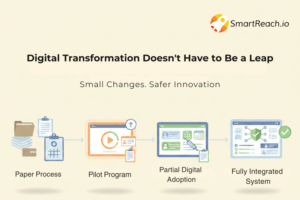Cold Calling vs Warm Calling: A comprehensive guide
Let’s break it down cold calling vs warm calling. What’s the difference and which one works better?
Cold calling involves reaching out to potential customers who haven’t shown interest in your product or service yet. It’s a bit like knocking on a stranger’s door. Naturally, this means you’ll face more rejections compared to warm calling.
Warm calling, however, is when you contact prospects who have already shown some level of interest or have interacted with your brand. But how do you convert more cold leads into warm ones?
This article will answer that question and explain the differences between cold calling and warm calling. Besides, you’ll get tips on how to succeed with each approach.
Learn how to effectively warm call and transform your sales strategy.
Keep reading to explore the ins and outs of cold calling vs warm calling, and discover how you can excel with both methods.
Let’s dive in!
Definitions: Cold calling vs Warm calling
Cold calling is when you make unexpected calls to people who don’t know you or your company, aiming to set up a meeting to pitch your product or service.
Imagine showing up at a party uninvited, trying to make new friends while hoping not to get kicked out.
So, why would anyone choose to do this?
Surprisingly, about 6.3% (as per our observation) of prospects are open to these calls, making it a solid method for generating leads.
In fact, it’s often more effective than cold emailing, which only has a 0.5% success rate (as we estimate). Cold calling, despite its challenges, can be a valuable tool in your sales strategy.
Warm calling involves reaching out to potential customers who have already shown some interest in your company. Here’s how it typically works:
Imagine Company ABC publishes several SEO-optimized blog posts each month. Customer XYZ stumbles upon one of these posts through Google, finds it valuable, and signs up for Company ABC’s email newsletter.
This indicates that XYZ is at least somewhat interested.
A sales rep at Company ABC notices the new email subscriber, researches the lead on LinkedIn (thank you, social selling!), and decides to make a call. During the conversation, the rep already knows a bit about the lead and can tailor the pitch accordingly.
This approach, though seemingly small, can significantly boost conversion rates.
Warm leads come in various forms and convert at different rates:
- Lukewarm leads have heard of your company but shown minimal interest, perhaps through an ad or a brief visit to your site.
- Toasty leads have engaged more meaningfully, maybe by downloading an eBook or whitepaper.
- Red hot leads have shown strong interest, like reading your blog and checking out your pricing page.
Warm calling leverages these pre-established connections, making it a highly effective sales strategy.
Cold calling vs warm calling
| Aspect | Cold calling | Warm calling |
| Definition | Reaching out to prospects with no prior contact or interest. | Contacting prospects who have shown some prior interest. |
| Initial contact | Unsolicited; the prospect is unfamiliar with the caller. | Solicited; the prospect has had some interaction with the company. |
| Preparation | Minimal information about the prospect. | Research and prior knowledge about the prospect. |
| Response rate | Generally low due to lack of prior relationship. | Higher due to established interest. |
| Conversion rate | Typically lower. | Typically higher. |
| Prospect’s awareness | Little to no awareness of the company or product | Some awareness and interest in the company or product. |
| Rejection rate | High; many prospects may not be interested at all. | Lower; prospects are more likely to be receptive. |
| Approach | Broad and often generalized. | Tailored and specific to the prospect’s interests. |
| Time investment | Quick calls, minimal research. | More time spent on research and personalization. |
| Lead quality | Often lower quality leads. | Higher quality leads. |
| Sales cycle | Longer; more time needed to build trust and interest. | Shorter; trust and interest are partially established. |
| Examples | Cold calls to random phone numbers or businesses. | Calling someone who downloaded a whitepaper or signed up for a webinar. |
When to use cold and warm call
Cold Calling
Use Cold Calling When:
- Your Resources Are Limited: If your sales team is small and you need to generate leads quickly, cold calling can be an efficient way to reach a broad audience without a lot of upfront investment.
- Testing New Markets: When entering a new market, cold calling allows you to gauge interest and gather feedback without heavily investing in marketing campaigns. It helps you understand the landscape and identify potential opportunities.
- Immediate Outreach Needs: If you need to quickly reach a large number of prospects, cold calling can get your message out there fast. This is especially useful for short-term promotions or urgent product launches.
Warm Calling
Use Warm Calling When:
- Maximizing Efficiency: Warm calling can make your cold calling efforts more effective. By first establishing some level of interest or relationship, you increase the likelihood of a positive response.
- Standing Out in a Crowded Market: In a market saturated with options, warm calling helps you differentiate yourself by showing prospects that you’ve already invested time in understanding their needs. This personalized approach can make a big difference.
- Leveraging Marketing Efforts: If your marketing team is producing valuable content (like eBooks, webinars, or whitepapers), use this to engage prospects before calling them. Sending these resources as part of your initial outreach can hook prospects and make your calls more welcome.
Cold calling and warm calling each have their place in a well-rounded sales strategy. Use cold calling to quickly test new markets and generate leads with limited resources.
Opt for warm calling to build on existing interest, stand out in competitive markets, and make the most of your marketing efforts.
By strategically choosing when to use each method, you can enhance your sales efficiency and effectiveness.

Which one is better?
In the modern B2B SaaS landscape, warm calling often outshines cold calling. Warm calling tends to be less intrusive, and prospects are more likely to remember your brand. This familiarity increases your chances of booking meetings and making successful sales. In today’s crowded market, sales reps who adopt a consultative selling approach generally see better results.
Why Warm Calling is Superior
- Less Intrusive: Warm calls feel more like a continuation of an existing conversation rather than an unexpected interruption, making prospects more receptive.
- Better Brand Recall: Prospects are more likely to remember and trust a brand they’ve interacted with before, whether through an email, a LinkedIn connection, or consuming valuable content.
- Consultative Selling Wins: Taking the time to understand your prospects’ needs and tailoring your approach accordingly makes your pitch more relevant and appealing.
How to Warm Up Your Cold Calls
To transform cold calls into warm ones, integrate these steps into your sales sequence:
- Email and LinkedIn Outreach: Start by reaching out via email or LinkedIn before making the call. This initial contact helps establish a connection.
- Share Valuable Content: Send prospects useful resources, like downloadable assets or informative articles, to build trust and demonstrate your value.
- LinkedIn Engagement: Connect with your prospects on LinkedIn, view their profiles, and engage with their posts to show genuine interest.
- Research Your Prospects: Spend a few minutes researching each prospect before calling. Use the information you gather to personalize your approach and make your call more relevant.
While cold calling has its place, warm calling is generally more effective in today’s B2B sales environment.
By investing time in building relationships and understanding your prospects, you can significantly improve your chances of success.
Adopting a warm calling strategy helps you stand out, fosters trust, and ultimately leads to better sales outcomes.
Tips for cold and warm call
Cold calling can lead to sales success—if you do it right. Here are six essential tips to ensure your calls are effective:
Tips for cold call
Research your contacts
Research is crucial for successful sales prospecting. Understand who you’re reaching out to by gathering information about their industry, company, and challenges. This information is often easily accessible through social media profiles, especially LinkedIn. The more you know about your prospects, the more relevant and productive your cold calls will be.
Plan out your cold calls
Never “wing it” during cold calls. Instead, prepare a plan to guide your conversations. Create a customizable sales script, something like this:
“Hi [First Name], I’m [Your Name] from [Your Company]. I’m calling because [Reason for Your Call]. Based on my research, I believe you’d be a great fit for our solution. If you’re interested, can we schedule a 15-minute call on [Time & Date]?”
Use this script as a guide rather than sticking to it verbatim. Flexibility will make you sound more natural and sincere.
Call at the right times
Timing is crucial. Research suggests the best times to cold call are between 3:00 p.m. and 5:00 p.m. on Tuesdays and Thursdays. However, it’s essential to experiment and find the optimal times that work best for your specific audience.
Prioritize the prospect
Focus on the prospect rather than immediately diving into your sales pitch. Ask questions, listen to their responses, and tailor your conversation to their needs. Building trust is key to a successful sales process.
Follow-up as needed
After your initial call, don’t forget to follow up. Call again in a week or a month, send an email or text, or engage with them on social media. Consistent follow-up can significantly improve your chances of making a sale.
Track your results
Monitor your cold-calling efforts. Are you connecting with prospects and generating sales? If not, analyze your approach and try new tactics. If you are successful, identify what’s working and double down on those strategies to further enhance your results.
Tips for warm call
Here are five tips to help you turn potential clients into paying customers consistently.
Get the basics right
While warm calling is a fantastic way to build your sales pipeline, it still shares similarities with cold calling. Here are some basics to keep in mind:
- Know who you’re calling. The more you know about your prospect, the better you can personalize your conversation.
- Just like cold calling, don’t wing it. Plan your approach to keep the conversation on track.
- Even if your leads are familiar with you, they won’t answer if they’re busy. Figure out the best times to reach them and call accordingly.
Ask open-ended questions
Open-ended questions require more than a simple “yes” or “no” answer and encourage prospects to share more about their situation. Here are some examples:
- “What solution are you currently using, and why isn’t it working?”
- “What is your biggest challenge?”
- “What tasks do you spend the most time on?”
These questions help engage prospects and provide valuable insights into their needs and pain points.
Listen to your potential clients
Don’t just ask questions; listen to the answers. Effective listening helps you identify pain points, suggest solutions, and build trust. Consider recording your calls (with permission) to review and improve your follow-up communications.
Provide Next Steps: Always end your warm call with a clear next step. This could be as simple as, “Can I send you a follow-up email?” or, “What if I call again next week to show you a demo?” This not only keeps the momentum going but also gives prospects the opportunity to opt out, saving you time in the long run.
Assess Your Sales Strategy: Regularly evaluate your warm-calling process. Are your calls converting? Are prospects engaging positively? If not, consider:
- Connecting with leads more personally before the call.
- Enhancing your research to be more prepared.
- Improving your lead qualification process.
Cold calling using SmartReach.io
SmartReach.io’s PowerCaller feature revolutionizes cold calling by enhancing efficiency and productivity.
Here’s how it stands out:
- Focused Calling Sessions: PowerDialer enables concentrated calling sessions, allowing you to add call sentiments for each call and get detailed reports on calling activities with specific call dispositions.
- Flexible Access: Calls can be made through the SmartReach extension or mobile app, giving you the freedom to manage your calls on the go.
- Cost and Trial: PowerCaller is available as an add-on for $19 per calling number. Additionally, you need Twilio calling credits for costs like number purchases, voice call charges, and call recordings. During the 14-day free trial, users get $5 in free credit to test the software.
Key features of PowerCaller
- Efficient Cold Calling: Sales reps can handle their daily cold calls effectively, maintaining a focused approach to boost productivity.
- Campaign Call Scripts: Helps reps stay on track and consistently deliver compelling sales pitches.
- Call Forwarding: Redirects calls to your mobile device, ensuring you never miss important callbacks even when you’re on the move.
- Real-Time Coaching: With Listen, Barge-in, and Whisper functionalities, supervisors can provide real-time coaching during live calls to address concerns and close deals effectively.
- Call Task Manager: Streamlines calling tasks by offering timely reminders and flexible scheduling options, helping you manage your workflow efficiently.
SmartReach.io’s PowerCaller is designed to maximize your cold calling efforts, ensuring every call is productive and every opportunity is seized.
Final words: cold calling vs warm calling
Cold calling vs warm calling each offers unique advantages in sales.
Cold calling is useful for quickly reaching a broad audience and testing new markets, though it often leads to higher rejection rates.
Warm calling, on the other hand, engages prospects who have shown interest, resulting in less intrusive and more effective conversations.
This approach requires more initial effort, such as thorough research and personalized outreach, but builds stronger connections and trust.
The best strategy combines both methods: cold calling for rapid lead generation and warm calling to foster relationships and close deals.
Cold calling vs warm calling: F.A.Q.s
What is an example of warm calling?
Warm calling occurs when a salesperson contacts someone who has shown prior interest in their product or service. For example, calling a potential client who downloaded an eBook from your website is a warm call.
What are examples of cold calling?
Cold calling examples include reaching out to individuals or businesses with no prior interaction. For instance, a salesperson calling homeowners to pitch a security system is a cold call.
What is B2B cold calling?
B2B cold calling involves businesses contacting other businesses to sell a product or service without prior interaction. For example, calling a company to pitch software solutions is B2B cold calling.
What are warm vs. cold calls?
Warm calls are made to individuals familiar with your brand or who have expressed interest. Cold calls are made to prospects with no prior interaction. Warm calls typically yield higher engagement rates than cold calls.
What is outbound calling?
Outbound calling is when sales or support representatives initiate calls to prospects or customers. It includes activities like cold calling, follow-ups, or customer feedback collection.
What is cold calling in CRM?
Cold calling in CRM refers to using customer relationship management tools to organize and streamline calls to new prospects. CRM systems track leads, schedule follow-ups, and store client information for effective cold outreach.
What is a warm call?
A warm call is a sales call to someone who is aware of your brand or has shown interest in your offerings, such as signing up for a newsletter or attending a webinar.
Is cold calling good or bad?
Cold calling can be effective when done strategically, such as targeting qualified leads. However, it is often viewed negatively when it is intrusive or lacks personalization.
What is hot vs. cold phone?
“Hot phone” refers to a ready or active communication line for specific tasks, like support lines. “Cold phone” implies unused or inactive lines or random calling efforts without prior engagement.




